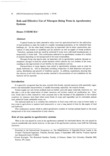Role and Effective Use of Nitrogen-fixing Trees in Agroforestry Systems
JIRCAS international symposium series
| ISSN | 13406108 |
|---|---|
| NII recode ID (NCID) | AA1100908X |

Full text
intlsymp-1_78-84.pdf225.44 KB
Tropical forests are often cleared to make room for agricultural land for the cultivation of food products to meet the needs of a rapidly increasing population, or for industrial land, buildings, etc. On the other hand, forests play an important role in water conservation, prevention of land erosion or landslides and air pollution as well as supply of forest products.
Therefore, optimum land use could be achieved if crops were cultivated simultaneously or temporarily in forest land. This combination referred to as agroforestry consists of a variety of systems depending on the background of the local communities.
Nitrogen-fixing tree species play on important role in agroforestry systems, because atmospheric nitrogen is fixed by certain bacteria which colonize the root nodules of the trees,
resulting in the improvement of soil fertility by this symbiotic activity.
Characteristics of some legume trees suited to agroforestry systems, such as trees for shade, fuelwood, etc. will be described, including comparison of seed dispersion and germination, distribution and growth of Erythrina species. In addition, experiments showing that the mixture of soil with charcoal powder resulted in the promotion of root nodulation by the bacteria will be reported.
Therefore, optimum land use could be achieved if crops were cultivated simultaneously or temporarily in forest land. This combination referred to as agroforestry consists of a variety of systems depending on the background of the local communities.
Nitrogen-fixing tree species play on important role in agroforestry systems, because atmospheric nitrogen is fixed by certain bacteria which colonize the root nodules of the trees,
resulting in the improvement of soil fertility by this symbiotic activity.
Characteristics of some legume trees suited to agroforestry systems, such as trees for shade, fuelwood, etc. will be described, including comparison of seed dispersion and germination, distribution and growth of Erythrina species. In addition, experiments showing that the mixture of soil with charcoal powder resulted in the promotion of root nodulation by the bacteria will be reported.
| Creator | Etsuzo UCHIMURA |
|---|---|
| Publisher | Japan International Research Center for Agricultural Sciences |
| Available Online | |
| Issue | 1 |
| spage | 78 |
| epage | 84 |
| Language | eng |
